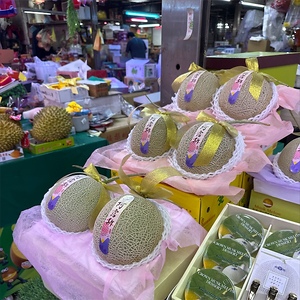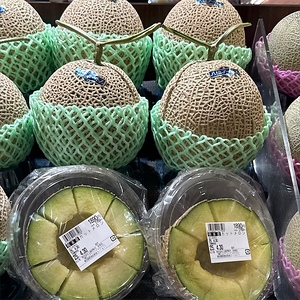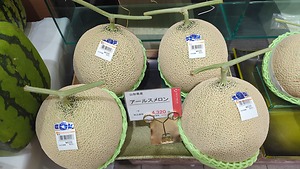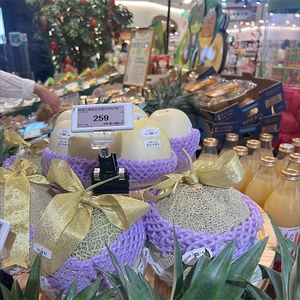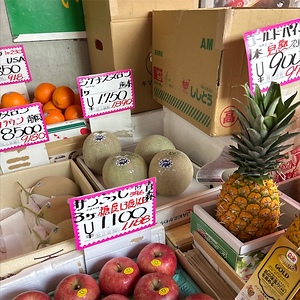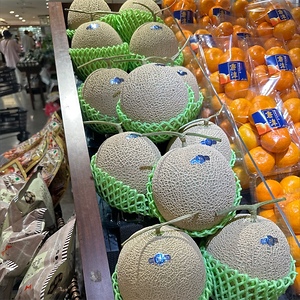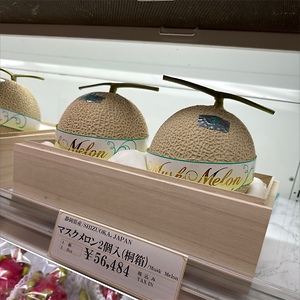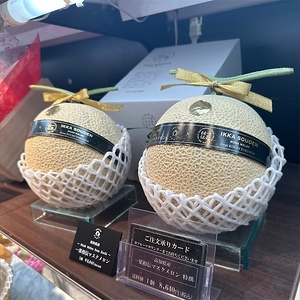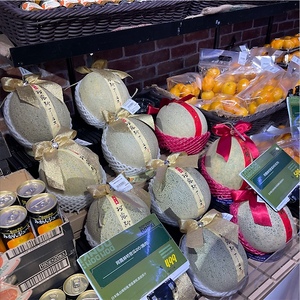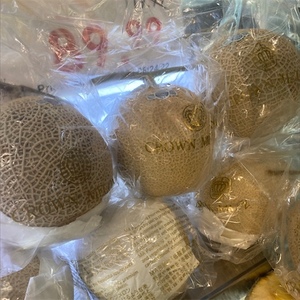


Arus Melons
Estimated Inventory, lb : 0
Description/Taste
Arus melons are a small to medium-sized varietal and have a round to oval shape with slightly flattened, curved ends. The melons have a distinct green, fibrous stem that typically grows in a “T” shape. When the melons are harvested, the stem is left intact for increased visual appeal and as a marker of freshness. The rind showcases variegated dark to light green hues and is covered in an interwoven, raised, net-like pattern. This three-dimensional netting is created from the fruit's interior growing slightly faster than the exterior, causing cracking. Once cracked, secretions from the flesh seep out and solidify, forming the raised texture. Underneath the netted surface, the flesh is dark green just below the rind, lightening to pale green hues in the center. The flesh is also semi-firm, aqueous, and tender, encasing a central cavity filled with cream-colored, oval seeds suspended in stringy fibers. Arus melons are aromatic and release fruity, tropical, and perfumed notes. The melons should feel heavy for their size, and the bottom of the fruit will give when pressed, a sign the melon is ripe. Arus melons have a delicate and refreshingly sweet, musky flavor.
Seasons/Availability
Arus melons are grown in greenhouses for year-round availability, with a peak season in the summer through early fall.
Current Facts
Arus melons, botanically classified as Cucumis melo, are a Japanese variety belonging to the Cucurbitaceae family. The netted melons are a type of muskmelon developed for their uniform appearance, aromatic nature, and sweet, tender flesh. Arus melons are among several improved cultivars created from the British melon known as Earl’s Favorite, a variety introduced into Japan during the 19th century. It is important to note that some retailers use the term Earl’s Favorite interchangeably with Arus due to the melon’s similarities. The muskmelons are grown year-round in glass greenhouses instead of vinyl to allow the fruits to receive maximum hours of sunlight, and strict cultivation standards are followed to create high-quality melons. Arus melons are a luxury fruit primarily consumed fresh to savor its texture and flavor.
Nutritional Value
Arus melons are a source of potassium to balance fluid levels within the body, fiber to regulate the digestive tract, and vitamin C to strengthen the immune system while reducing inflammation. The melons also provide vitamin K to assist in faster wound healing, vitamin E to protect the cells against free radical damage, calcium to build strong bones and teeth, and other nutrients, including iron, folate, copper, manganese, and magnesium.
Applications
Arus melons have a sweet, perfumed flavor and a tender, aqueous flesh suited for fresh preparations. The melons are traditionally consumed straight out of hand, and it is recommended to chill the flesh before serving. Arus melons can be scooped from the rind and tossed into salads, mixed into fruit bowls, or cut into slices and served on appetizer platters. The melons can also be wrapped in prosciutto as a salty-sweet dish, incorporated into chilled summer soups, blended into smoothies, or pressed into fresh juices and cocktails. Try using Arus melons in sorbet, granita, or popsicle recipes for a sweet, refreshing taste. The melons can also be pureed into a dressing, stirred into grain bowls, made into a carpaccio, or their floral sweetness balances well against recipes using tart, spicy, and salty ingredients. Arus melons pair well with herbs such as cilantro, mint, and basil, fruits including lemons, limes, grapes, and figs, pumpkin seeds, almonds, vanilla, ginger, and nuts such as almonds, pine, and walnuts. Whole, unopened Arus melons should be kept at room temperature to ripen and in the refrigerator once ripe. Once sliced, the pieces should be wrapped in plastic or stored in a sealed container in the fridge for 5 to 7 days.
Ethnic/Cultural Info
Japanese muskmelons are a luxury fruit worldwide due to their strict cultivation standards. One of the most prized varieties developed from the Earl’s Favorite melon is the Crown melon. This improved cultivar is produced in the Shizuoka Prefecture in controlled glass greenhouses. These greenhouses can be opened and closed electronically to control temperature, humidity, and air circulation, and each plant is only allowed to grow one fruit to ensure all the nutrients and sugars are absorbed into the melon. Even within the Crown melon variety, there are four grades of fruit, ranked according to sugar content, size, shape, and overall appearance. Crown melons are distinguished by their embellished crown sticker labels and are sold through high-end retailers as gifts. A Crown melon was once given to the Queen of England when she visited Japan, and the melon was received with words of praise.
Geography/History
Arus melons are a type of muskmelon native to Japan. The variety was created as an improved cultivar of the Earl’s Favorite melon, a variety introduced from the United Kingdom in 1925 during the Taisho Period. Legend has it the melon was grown on the farm of the Earl of Radnor in England and was named after the Earl as he favored the sweet fruits. Once Earl’s Favorite melons were introduced to Japan, they were used at several research facilities to create improved melon varieties, including Arus melons. It is important to note that the improved cultivars are often collectively known as Earl’s Melons in Japan, a descriptor given in honor of the melon’s parentage. Today Arus melons are primarily grown in the Shizuoka prefecture, the Ibaraki Prefecture, and the Kumamoto Prefecture in Japan and are sold through farms, markets, and specialty grocers. The variety is also being cultivated in Malaysia as a high-end fruit.
Recipe Ideas
Recipes that include Arus Melons. One



